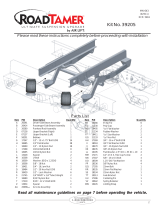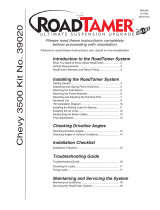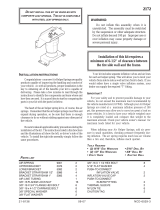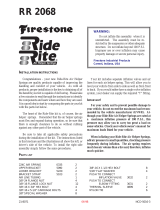Page is loading ...

Technical Support
1-800-248-0892
Ext. 2
MN-495
(01112)
NPR 3719
Please read these instructions completely before proceeding with installation
Kit No. 59551
by
www.airliftcompany.com
N
C
A
B
J
K
F
E
H
G
I
L
K
M
O
Driver Side Installation
Parts List
Item P/N Description Quantity
A 58571 Air Spring 2
B 07940 Upper Bracket 2
C 03616 Lower Bracket 2
D 10622 Installation Tool 1
E 21837 Air Fitting 2
F 18454
3
/4” Nylon Nut 2
G 17124
1
/2”-13 x
7
/8” Bolt 2
H 18414
1
/2” Flat Washer, SAE 2
I 01426 Clamp Bar 2
J 10583
3
/8” x 3.5” x 4.5” U-bolt 2
K 18435
3
/8” Nyloc Nut 11
L 18444
3
/8” Flat Washer, SAE 4
M 18447
3
/8” Large Flat Washer 7
N 17243
3
/8” Washer Head Bolt 7
O 17129
3
/8” x 1 Self Tapper 1
AA 20086
sub Air Line Assembly 1
BB 10466 Tie Strap 6
CC 21230 Valve Cap 2
DD 18405
5
/16” Flat Washer 2
EE 21234 Rubber Washer 2
FF 18411 Star Washer 2
GG 21233
5
/16” Hex Nut 4
IMPORTANT: This kits mounts
behind the axle. Figure 1
shows the installation for the
driver side only. Refer to
Figure 7 for the passenger side
installation.
Figure 1

Technical Support
1-800-248-0892
Ext. 2
NOTE:
The measurement
from
one end of the arrow to
the
other end is the Normal
Ride Height.
Tools Needed
IMPORTANT: Your vehicle may be equipped with a rear brake proportioning valve. Any type of load assist product could
affect brake performance. We recommend that you check with your dealer before installing this type of product. If your
vehicle DOES NOT have a rear brake proportioning valve or is equipped with an anti-lock type brake system, installation
of a load assist product will have NO EFFECT ON BRAKE SYSTEM PERFORMANCE.
7
/16”,
9
/16” open-end or box wrenches
Crescent Wrench
Ratchet with
3
/8”,
9
/16”, and
1
/2” deep well sockets
3
/8” and
5
/16” drill bits (very sharp)
3
/8” Nut Driver
Heavy Duty Drill
Torque Wrench
Hose Cutter, Razor Blade, or Sharp Knife
Hoist or Floor Jacks
Safety Stands
Safety Glasses
Air Compressor, or Compressed Air Source
Spray Bottle with Dish Soap/Water Solution
I. Getting Started
1. Determine the Normal Ride Height. The Normal Ride Height is
the distance between the bottom edge of the wheel-well and the
center of the hub with the vehicle in the “as delivered” condition.
In some cases, Normal Ride Height is not perfectly level.
a. Remove unusual loads and examine your vehicle from the
side to ensure it is on a level surface.
b. If necessary (in cases where your leaf springs are sagging
badly), use a jack to raise the rear end so that the vehicle
achieves the original “as delivered” ride height.
2. Measure the distance between the center of the hub and the
bottom edge of the wheel well (Figure 2). This is the Normal
Ride Height. Enter the measurement below:
NORMAL
RIDE HEIGHT: __________ inches
3. Measure the distance between the frame and the tire. This kit
requires a minimum of 6” of clearance for a fully inated air spring
(Figure 3).
II. Raising the Vehicle
1. Raise the vehicle and remove the wheels.
2. Check the distance between the center of the hub and the
bottom edge of the wheel to ensure that it is at the normal ride
height recorded above. If not, raise the frame or lower the axle
as necessary to restore the original distance.
a. If the vehicle is raised with an axle contact hoist, place axle
stands under the frame and lower the axle as needed.
b. If the vehicle is raised with a frame contact hoist, place axle
stands under the axle and lower the frame as needed.
c. If the vehicle is raised with a jack and supported with axle
stands on the frame, use a oor jack to lower the axle.
Figure 2
Figure 3

Technical Support
1-800-248-0892
Ext. 2
5.1"
Figure 5
Figure 6
Figure 4
III. Assembling the Installation Tool
1. The tool provided with this kit will assist in proper setup and
alignment of the air spring and will also position the upper bracket
for drilling the bolt holes. The tool attaches to the upper and lower
bracket and is rigid so that it will self-align the upper bracket.
The threaded section of the upper part of the tool ensures that
the air spring can only be mounted at the correct height. The
air spring will work throughout the entire threaded range on the
tool. This kit will mount behind the axle.
2. Secure the upper bracket (B) to the installation tool (D) using
the provided nylon nut (F) (Figure 4).
3. Loosely attach the tool to the lower bracket (C) using
1
/2” at
washer (H) and
1
/2” bolt (G). Refer to Figure 4. Leave loose for
adjustment.
IV. Attaching the Lower Bracket
1. Set the assembly on the leaf spring behind the axle.
2. With the hook end of the lower bracket placed over the edge of
the spring retaining plate (Figure 5), secure the lower bracket
to the leaf spring with the provided U-bolt (J), clamp bar (I), at
washers (L), and lock nuts (K). Torque to 16 ft-lbs.
NOTE: The bracket will pull down at to the leaf spring when
the lock nuts are tightened.
3. The air spring will expand to 5.1” in diameter at maximum ination
pressure. Check horizontally along the shaft of the installation
tool for sufcient clearance of 2.50” all around the tool (Figure
6).
V. Positioning the Upper Bracket
1. Using the slot in the lower bracket, push the upper bracket against
the frame rail.
2. Use the two nylon nuts on the threaded portion of the tool to
adjust the upper bracket so that the legs are at against the
frame rail and all four holes are in the middle section of the
frame. The mounting holes must not fall on the rounded edges
of the frame rail and at least 1.5” must be left above the top of
the upper bracket for air tting clearance.
Installation
Tool
Lower
Bracket
Nylon Nut,
Flange Down
Nylon Nut
1/2" Flat Washer
1/2" HHCS

Technical Support
1-800-248-0892
Ext. 2
VI. Attaching the Upper Bracket
IMPORTANT: Please read this entire section completely before
drilling any holes.
1. CAUTION: Before drilling, check the back side of the frame for
clearance issues such as, brake lines, gas lines, electrical lines,
etc. All obstacles need to be temporarily relocated to clear the
area.
2. DRIVER SIDE INSTALLATION:
a. Center punch the lower rear hole and drill a
3
/8” hole through
the frame.
b. Loosely install a
3
/8” washer head bolt (N), a large at washer
(M), and nylock nut (K).
Figure 7
Passenger Side
c. Center punch the forward lower hole and drill a
3
/8” hole through the frame.
d. Remove the tool by removing the bolt securing the tool to the lower bracket. Swing the bracket up and remove
the nylon nut on the top of the upper bracket. Remove the tool. Save the hardware, as it will be reused to mount
the air spring.
e. Replace the upper bracket to the mounting location and secure at the forward, lower mounting hole location
using
3
/8” washer head bolt (N), large at washer (M) and nylock nut (K) as shown in Figure 1.
f. Center punch and drill a
5
/16” hole for the forward upper hole and install a
3
/8” self tapper (O). Tighten to 16 ft-lbs
(Figure 1).
g. Drill the remaining hole out to a
3
/8” diameter and install a
3
/8” washer head bolt (N), a large at washer (M), and
a nyloc nut (K).
3. PASSENGER SIDE INSTALLATION: Install the passenger side assembly in the same manner, with the exception
to the forward upper hole location. Drill this hole to a
3
/8” diameter and install a
3
/8” washer head bolt (N), a large
at washer (M), and a nyloc nut (K). No self tapper is used on the passenger side. Refer to Figure 7.
VII. Installing the Air Spring
1. Install 90 degree air swivel tting (E) to the top of the air spring (A) (Figure 1). Use a
7
/16” open end wrench being
careful to tighten on the metal hex nut only. Tighten 1
1
/2 turns. Do not over tighten. NOTE: This fitting is
precoated with sealant.
2. Guide the tting through the center mounting hole in the upper bracket (Figure 1).
3. Attach the air spring to the lower bracket using at washer (H) and bolt (G). Carefully hand turn the air spring onto
the lower mounting bolt. Leave loose for later adjustment.
4. Loosely, install nylon nut (F) over the air tting and onto the upper threadpost of the air spring (Figure 1).

Technical Support
1-800-248-0892
Ext. 2
Air Line to
Bellows
FF
Vehicle body
or bumper
GG
GG
EE
DD
CC
Figure 9
Figure 8
VIII. Aligning the Air Spring
1. IMPORTANT: With the bottom and top of the air spring still
loose, inate the air spring to approximately 10 p.s.i.
2. Use the slotted adjustment in the lower bracket to correctly align
the air spring between the upper and lower brackets. This can
be accomplished by lightly tapping it inboard or outboard for
proper alignment. There should be a symmetrical cushion of
air around the base of the air spring when correctly positioned
(Figure 8).
3. Tighten the lower mounting bolt with a
3
/4” wrench. Hand tight
is sufcient. Do not attempt to hold the air spring with any type
of tool.
4. Tighten the nylon nut to 4 ft-lbs.
5. Repeat entire installation procedure for other side.
IX. Installing the Air Lines
1. Choose a convenient location for mounting the ination valves.
Popular locations for the ination valve are: the wheel well
anges, the license plate recess in bumper, under the gas cap
access door, or through license plate itself.
NOTE: What ever the chosen location is, make sure there
is enough clearance around the inflation valves for an air
chuck.
E
q
u
a
l
C
u
s
h
i
o
n
o
f
A
i
r
PISTON
Flex Member
2. Drill a
5
/16 “ hole to install the ination valves.
3. Cut the air line assembly (AA) in two equal lengths.
CAUTION: When cutting or trimming the air line, use a hose cutter, a razor blade or a sharp knife. A clean,
square cut will ensure against leaks. Do not use wire cutters or scissors to cut the air line. These tools
may flatten or crimp the air line, causing it to leak around the O-ring seal inside the elbow fitting.
4. Place a
5
/16 “ nut (GG) and a star washer (FF) on the air valve. Leave enough of the ination valve in front of the
nut to extend through the hole and have room for the rubber washer (EE), at washer (DD), and
5
/16 “ nut (GG) and
cap (CC). There should be enough valve exposed after installation - approximately
1
/2 “ - to easily apply a pressure
gauge or an air chuck (Figure 9).
5. Push the ination valve through the hole and use the rubber washer (EE), at washer (DD), and another
5
/16 “ nut
(GG) to secure it in place. Tighten the nuts to secure the assembly in place (Figure 9).
6. Route the air line along the frame to the air tting on the air spring. Keep at least 6” of clearance between the air
line and heat sources, such as the exhaust pipes, mufer, or catalytic converter. Avoid sharp bends and edges.
Use the plastic tie straps (BB) to secure the air line to xed, non-moving points along the chassis. Be sure that the
tie straps are tight, but do not pinch the air line. Leave at least 2” of slack to allow for any movement that might
pull on the air line.
7. Cut off air line leaving approximately 12” of extra air line. A clean square cut will ensure against leaks. Insert the
air line into the air tting. This is a push to connect tting. Simply push the air line into the 90° swivel tting until it
bottoms out (
9
/16” of air line should be in the tting).
8. Install the minimum/maximum air pressure decal in a highly visible location. We suggest placing it on the driver’s
side window just above the door handle.

Technical Support
1-800-248-0892
Ext. 2
X. Checking for Leaks
1. Inate the air spring to 30 p.s.i.
2. Spray all connections and the ination valves with a solution of
1
/5 liquid dish soap and
4
/5 water to check for leaks.
You should be able to spot leaks easily by looking for bubbles in the soapy water.
3. After the test, deate the springs to the minimum pressure required to restore the Normal Ride Height, but not less
than 5 p.s.i.
4. IMPORTANT: Check the air pressure again after 24 hours. A 2 to 4 p.s.i. loss after initial installation is normal.
Retest for leaks if the loss is more than 5 lbs.
XI. Fixing Leaks
1.
If there is a problem with the swivel tting, then:
a. Check the air line connection by deating the spring and removing the line by pulling the collar against the
tting and pulling rmly on the air line. Trim 1” off the end of the air line. Be sure the cut is clean and square.
Reinsert the air line into the push-to-connect tting.
b. Check the threaded connection by tightening the swivel tting another
1
/2 turn. If it still leaks, deate the air
spring, remove the tting, and re-coat the threads with thread sealant. Reinstall by hand tightening as much as
possible, then use a wrench for an additional two turns.
2. If there is a problem with the ination valve, then:
a. Check the valve core by tightening it with a valve core tool.
b. Check the air line connection by removing the air line from the barbed type tting. CAUTION: Do not cut it
off. As this will usually nick the barb and render the fitting useless. Cut air line off a few inches in front
of the tting and use a pair of pliers or vise-grips to pull/twist the air line off the tting.
3. If the preceding steps have not resolved the problem, call Air Lift Technical Service at 1-800-248-0892 for
assistance.
XII. Troubleshooting Guide
Problems maintaining air pressure, without on-board compressor.
1. Leak test the air line connections and threaded connection of the elbow into the air spring. See Section XI to
repair.
2. Leak test the ination valve for leaks at the air line connection or dirt or debris in the valve core. See Section XI to
repair.
3. Inspect air lines to be sure it is not pinched. Tie straps may be too tight. Loosen or replace strap. Replace leaking
components.
4. Inspect air line for holes and cracks. Replace as needed.
5. A kink or fold in the air line. Reroute as needed.

Technical Support
1-800-248-0892
Ext. 2
XIII. Checklist
You can protect your warranty on this product and prevent unnecessary wear by ensuring the following checks
have been made:
Section I – Installation (To be completed by the installer):
Section II - Post Installation Checklist (To be completed by the owner):
1. Clearance Test - Inate the air springs to 60 p.s.i. and ensure there is at least
1
/2 “ clearance around
each sleeve from anything that might rub against them. Be sure to check the tire, brake drum, frame,
shock absorbers and brake cables.
2. Leak Test Before Road Test – Inate the air springs to 60 p.s.i., check all connections for leaks with
a soapy water solution. See page 6 of the manual for tips on how to spot leaks. All leaks must be
eliminated before the vehicle is road tested.
3. Heat Test – Be sure there is sufcient clearance from heat sources - at least 6” for air springs and air
lines. If a heat shield was included in the kit - install it. If there is no heat shield, but one is required,
call 1-800-248-0892.
4. Fastener Test – Recheck all bolts for proper torque.
Torque Guide:
3
/8 “ Frame Bolts 16 ft-lbs
U-bolt Lock Nuts 16 ft-lbs
5. Road Test – The vehicle should be road tested after the preceding tests. Inate the springs to 25
p.s.i. (50 p.s.i. if vehicle is loaded). Drive the vehicle 10 miles and recheck for clearance, loose
fasteners and/or air leaks.
6. Operating Instructions – If professionally installed, the installer should review the operating instructions
on page 8 with the owner. Be sure to provide the owner with all of the paperwork that came with the
kit.
1. Overnight Leakdown Test – Recheck air pressure after vehicle has been used for 24 hours. If pressure
has dropped more than 5 p.s.i. then, you have a leak that must be xed. Either x the leak yourself (see
page 6) or return to the installer for service.
2. Air Pressure Requirements – I understand that the air pressure requirements of my air spring system are
as follows:
Minimum ___________ Maximum ___________
I also understand that I must inate the air springs until the Ride Height measurement that was recorded
on page 2 has been restored. Regardless of load, the air pressure should always be adjusted so that the
Ride Height is maintained at all times.
3. Thirty Day or 500 Mile Test. I understand that I must recheck the air spring system after 30 days or 500
miles, whichever comes rst. If any part shows signs of rubbing or abrasion, the source should be identied
and moved, if possible. If it is not possible to relocate the cause of the abrasion, the air spring may need
to be remounted. If professionally installed, the installer should be consulted. Check all fasteners for
tightness.

Technical Support
1-800-248-0892
Ext. 2
XIV. Maintenance and Operations
By following these steps, vehicle owners will obtain the longest life and best results from their air
springs.
1. Check the air pressure weekly.
2. Always maintain Normal Ride Height. Never inate beyond 100 p.s.i.
3. If you develop an air leak in the system, use a soapy water solution to check all air line connections and the ination
valve core before deating and removing the air spring (see page 6).
4. When increasing load, always adjust the air pressure to maintain the Normal Ride Height. Increase or decrease
pressure from the system as necessary to attain Normal Ride Height for optimal ride and handling. Remember
that loads carried behind the axle (including tongue loads) require more leveling force (pressure) than those carried
directly over the axle.
5. IMPORTANT: For your safety and to prevent possible damage to your vehicle, do not exceed maximum Gross
Vehicle Weight Rating (GVWR), as indicated by the vehicle manufacturer. Although your air springs are rated
at a maximum ination pressure of 100 p.s.i. The air pressure actually needed is dependant on your load and
GVWR, which may be less than 100 p.s.i. Check your vehicle owners manual and do not exceed the maximum
load listed for your vehicle.
6. Always add air to springs in small quantities, checking the pressure frequently. Sleeves require less air volume
than a tire and inate quickly.
7. Should it become necessary to raise the vehicle by the frame, make sure the system is at minimum pressure
(5 p.s.i.) to reduce the tension on the suspension/brake components. Use of on–board leveling systems
do not require deflation or disconnection.
5 p.s.i.
100 p.s.i.
Failure to maintain correct minimum pressure (or pressure proportional to
load), bottoming out, over-extension, or rubbing against another component
will void the warranty.
Maximum Air PressureMinimum Air Pressure
10
10
“The Choice of the Professional Installer”
For Technical Assistance call 1-800-248-0892
Thank you for purchasing Air Lift Products
Mailing Address: Street Address:
AIR LIFT COMPANY AIR LIFT COMPANY
P.O. Box 80167 2727 Snow Rd.
Lansing, MI 48908-0167 Lansing, MI 48917
Local Phone: (517) 322-2144
Fax: (517) 322-0240
Printed in the USA
/





